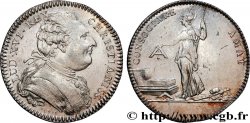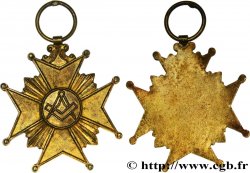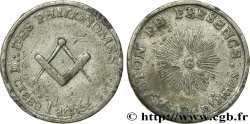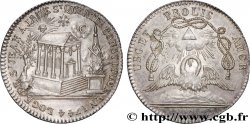fjt_1044292 - FRANC-MAÇONNERIE - PARIS Orient de Saint Quentin, Loge de Saint Jean 1744
240.00 €
Menge
In den Warenkorb

Type : Orient de Saint Quentin, Loge de Saint Jean
Datum: 1744
Name der Münzstätte / Stadt : SAINT-QUENTIN
Metall : Silber
Durchmesser : 28 mm
Stempelstellung : 12 h.
Gewicht : 6,97 g.
Rand cannelée
Punze : sans poinçon
Kommentare zum Erhaltungszustand:
Patine hétérogène avec des traces d’usure. Présence de points d’oxydation. Paille dans le métal à 8 heures à l’avers et 10 heures au revers
Vorderseite
Titulatur der Vorderseite LOGE. DE. ST. JEAN. A. L°. DE. ST. QUENTIN. CONSTITUEE. EN. 1744.
Beschreibung Vorderseite Temple, acacia à gauche, obélisque portant équerre, compas et phénix à droite, au-dessus, visage rayonnant (soleil), étoile flamboyante portant la lettre G, lune.
Rückseite
Titulatur der Rückseite URGET. PROLIS. AMOR..
Beschreibung Rückseite Une cordelière à trois lacs d’amour surmonte un triangle lumineux où sont inscrits un oeil et le tétragramme, surmontant lui-même un pélican nourrissant ses petits de ses entrailles.
Kommentare
La franc-maçonnerie s’implante en France aux alentours du premier quart du XVIIIe s. sous l’influence d’aristocrates anglais. Initiatique, elle est fondée sur le rite hiramique, du nom d’Hiram de Tyr, personnage biblique, architecte du roi Salomon sur le chantier du Temple et qui a résisté à la torture sans livrer ses secrets. Hiram a aussi donné un point de départ du calendrier maçonnique commençant 4000 ans avant le calendrier chrétien. Les symboles servent de signes de reconnaissance entre les initiés, notamment des outils de constructeur de cathédrales (équerre, compas, niveau, maillet, etc.), des formes (triangle, étoile), des nombres (trois, cinq, sept) et des lettres.
Freemasonry was established in France around the first quarter of the 18th century under the influence of English aristocrats. An initiatory practice, it is based on the Hiramic rite, named after Hiram of Tyre, a biblical figure, architect of King Solomon on the construction site of the Temple, who withstood torture without revealing his secrets. Hiram also provided a starting point for the Masonic calendar, which began 4,000 years before the Christian calendar. Symbols serve as signs of recognition between initiates, including cathedral builder's tools (set square, compass, level, mallet, etc.), shapes (triangle, star), numbers (three, five, seven), and letters.
Freemasonry was established in France around the first quarter of the 18th century under the influence of English aristocrats. An initiatory practice, it is based on the Hiramic rite, named after Hiram of Tyre, a biblical figure, architect of King Solomon on the construction site of the Temple, who withstood torture without revealing his secrets. Hiram also provided a starting point for the Masonic calendar, which began 4,000 years before the Christian calendar. Symbols serve as signs of recognition between initiates, including cathedral builder's tools (set square, compass, level, mallet, etc.), shapes (triangle, star), numbers (three, five, seven), and letters.








 Berichten über einen Fehler
Berichten über einen Fehler Die Seite drucken
Die Seite drucken Teilen meiner Auswahl
Teilen meiner Auswahl Stellen Sie eine Frage
Stellen Sie eine Frage Einlieferung/Verkauf
Einlieferung/Verkauf
 Details
Details












